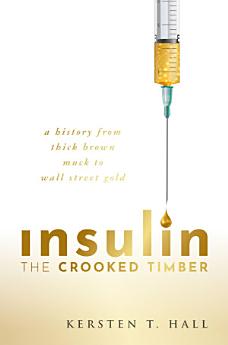Insulin - The Crooked Timber: A History from Thick Brown Muck to Wall Street Gold
Dec 2021 · Oxford University Press
Ebook
440
Pages
family_home
Eligible
info
reportRatings and reviews aren’t verified Learn More
About this ebook
Before the discovery of insulin, a diagnosis of Type 1 diabetes was a death sentence. One hundred years after a milestone medical discovery, 'Insulin - The Crooked Timber' tells the story of how insulin was transformed from what one clinician called 'thick brown muck' into the very first drug to be produced using genetic engineering, one which would earn the founders of the US biotech company Genentech a small fortune. Yet when Canadian doctor Frederick Banting was told in 1923 that he had won the Nobel Prize for this life-saving discovery, he was furious. For the prize had not been awarded to him alone - but jointly with a man whom he felt had no right to this honour. The human story behind this discovery is one of ongoing political and scientific controversy. Taking the reader on a fascinating journey, starting with the discovery of insulin in the 1920s through to the present day, 'Insulin - The Crooked Timber' reveals a story of monstrous egos, toxic career rivalries, and a few unsung heroes such as two little known scientists whose work on wool fibres, carried out in a fume-filled former stable, not only proved to be crucial in unravelling the puzzle of insulin but ushered in a revolution in biology. It was the author's own shocking diagnosis with Type 1 diabetes that prompted him to sit down and write this book, but this story has lessons for us all about what technology can - and more importantly cannot - do for us. As the world pins its hopes on effective and lasting vaccines against Covid-19, these lessons from the story of insulin have never been more relevant.
About the author
Kersten Hall graduated with an honours degree in biochemistry from St. Anne's College, University of Oxford, and completed a PhD in gene regulation in adenoviruses before working for the School of Medicine at the University of Leeds. He then hung up his lab coat and began to write about science. His book 'The Man in the Monkeynut Coat' (OUP 2014) tells the story of pioneering physicist William Astbury whose research into wool fibres led him to make the very first studies of the structure of DNA. The book was shortlisted for the 2015 British Society for the History of Science Dingle Prize and was featured on a list of 'Books of 2014' in The Guardian. He is currently a visiting fellow in the School of Philosophy, Religion and History of Science at the University of Leeds where his research concerns the history of molecular biology but after a shocking diagnosis with Type 1 diabetes ten years ago he turned to the story of insulin.
Rate this ebook
Tell us what you think.
Reading information
Smartphones and tablets
Install the Google Play Books app for Android and iPad/iPhone. It syncs automatically with your account and allows you to read online or offline wherever you are.
Laptops and computers
You can listen to audiobooks purchased on Google Play using your computer's web browser.
eReaders and other devices
To read on e-ink devices like Kobo eReaders, you'll need to download a file and transfer it to your device. Follow the detailed Help Center instructions to transfer the files to supported eReaders.





